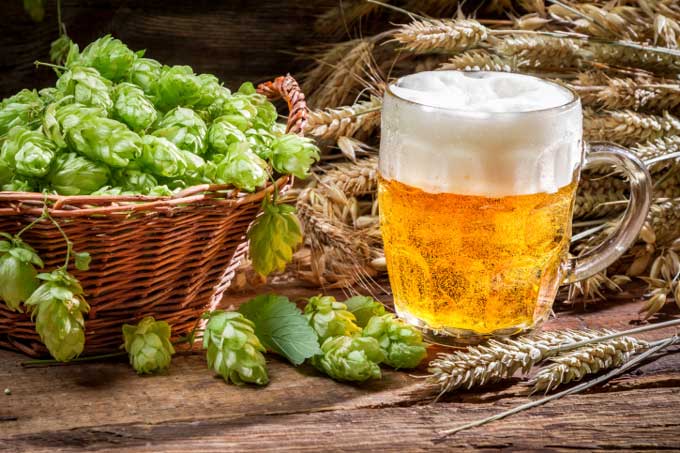Ode to Hops
by Willard Brooks

The Beauty of Bitterness
The craft beer revolution, as it’s sometimes called, has become, for better or worse, almost synonymous with beers heavy in their hops content. This column covers three of the most common hop forward ales: American Pale Ales (APA), India Pale Ales (IPA), and Double India Pale Ales (DIPA). The goal of this is to examine both the historical interconnection between these styles and highlight the range of hop-character present in local versions of moderately hopped pale ales, aggressively hopped IPAs, and massively hopped double IPAs.
Pale Ale is a major world beer style that originated 300 years ago in Burton on Trent with the kilning of malt over coke rather than wood fire. Malt thus prepared is lighter in color. Thus, the name “pale ale” derives from the fact that beer made from predominantly pale malt is pale in color. American pale ales (APA), unlike their British counterparts, tend to have a pronounced citrusy hop character from dry hopping using American hop varieties. The standard bearer in this category for decades has been Sierra Nevada Pale Ale, however, the current U.S. scene is packed with excellent APAs. One new trend that is toward ultra light lawnmower beers that slake those thirsts of summer. The best new twists involve late hop additions with less emphasis on hop bitterness and more on hop flavor and aroma.
■ Old First Ward Brewing, Not a Pale Ale (Pale Ale) 5.5%—This sports a restrained aroma with nice malt middle yielding to citrus floral with a more resin hop bite at the end which surprises the drinker—hop heads will enjoy this. Similar to Fiddlehead Pale Ale.
■ Community Beer Works, Frank Pale Ale 4.6%—though this beer has a cosy caramel and fruity edge, it’s also a pungent hop-forward west-coast style ale, which makes this one very unique. This beer gets compared to the best of west and east—Bear Republic Pale Ale & Edward pale ale from Hill Farmstead. Am I the only one who wished this would come in cans?
India Pale Ale (IPA) is a hoppier version of the pale ale style first brewed in the late 18th century in England with additional hops and alcohol to survive the boat trip to British colonial troops stationed in India. The English IPAs of the 19th century had tremendous hop bitterness and substantial hop aroma from dry-hopping with English hop varieties. American IPA has evolved over the last 30 years into a quite different form with often pronounced bitterness and substantial malt bills with tropical hop flavors and aromas primarily from American but increasingly from New Zealand hop varieties. IPA continues to be an evolving style, even after hundreds of years. These days there are new trends that add dark malts to produce beers such as “Black IPA” or the redux of historical styles such as Export India Porter. On the other end of the spectrum are “Session IPAs” with assertive hop profiles and low alcohol content. There are also IPLs (India Pale Lagers) as well as White IPAs (wheat IPAs with Belgian edges). This evolution is both interesting and delicious—it will be fun to see what comes next.
■ Flying Bison Buffalo IPA 6.4%—this has an intense and complex hop nose, powerful pine, lemon citrus flavors and is a solid and impressive IPA. A local beer geek with street cred, compares this to Mikkeller’s Better Half IPA.
■ Big Ditch, Hayburner IPA 7.0%—A juicy and citrusy IPA, with flashes of dank bitterness but balanced to the end. Yum!
Double IPAs (DIPAs) are a stronger, very hoppy variant of IPAs that typically have an alcohol content above 7.5%. Double IPAs are a high wire act balancing startling amounts of hops with heaps of malt and a resulting strong alcohol presence that can climb past 10%. It takes a great deal of skill to make a beer with these ingredients and have the style and grace that the best of them deliver. The style is thought to have originated in Southern California at Blind Pig Brewery by Vinnie Chiluzo who has since gone on to found the Russian River Brewing Company which produces Pliny the Elder IPA.
■ Pearl Street Grill & Brewery, Sabers Edge Double IPA 8.1%—One might note a boozy nose and a booze forward flavor with a piney/resinous bitterness at the end—but this is exactly what is needed before heading to a Sabers game! Like Sierra Nevada Celebration Ale on steroids!
■ Southern Tier 2XIPA DIPA 8.2%—This is a pale yellow DIPA that is all hops and no malt with a noticeable tropical dank hops nose and malt sweetness that travels down a hops coated throat. Pair with a big stilton cheese and stay in for the night.
Beer coverage done in partnership with Buffalo Niagara Brewers Association. Visit www.BuffaloNiagaraBrewersAssociation.org.
blog comments powered by Disqus|
Issue Navigation> Issue Index > v14n41 (Week of Thursday, October 15) > Ode to Hops This Week's Issue • Artvoice Daily • Artvoice TV • Events Calendar • Classifieds |









 Current Issue
Current Issue